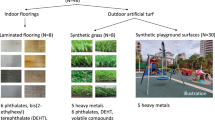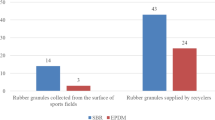Abstract
Many synthetic turf fields consist of not only artificial grass but also rubber granules that are used as infill. The public concerns about toxic chemicals possibly contained in either artificial (polyethylene) grass fibers or rubber granules have been escalating but are based on very limited information available to date. The aim of this research was to obtain data that will help assess potential health risks associated with chemical exposure. In this small-scale study, we collected seven samples of rubber granules and one sample of artificial grass fiber from synthetic turf fields at different ages of the fields. We analyzed these samples to determine the contents (maximum concentrations) of polycyclic aromatic hydrocarbons (PAHs) and several metals (Zn, Cr, As, Cd, and Pb). We also analyzed these samples to determine their bioaccessible fractions of PAHs and metals in synthetic digestive fluids including saliva, gastric fluid, and intestinal fluid through a laboratory simulation technique. Our findings include: (1) rubber granules often, especially when the synthetic turf fields were newer, contained PAHs at levels above health-based soil standards. The levels of PAHs generally appear to decline as the field ages. However, the decay trend may be complicated by adding new rubber granules to compensate for the loss of the material. (2) PAHs contained in rubber granules had zero or near-zero bioaccessibility in the synthetic digestive fluids. (3) The zinc contents were found to far exceed the soil limit. (4) Except one sample with a moderate lead content of 53 p.p.m., the other samples had relatively low concentrations of lead (3.12–5.76 p.p.m.), according to soil standards. However, 24.7–44.2% of the lead in the rubber granules was bioaccessible in the synthetic gastric fluid. (5) The artificial grass fiber sample showed a chromium content of 3.93 p.p.m., and 34.6% and 54.0% bioaccessibility of lead in the synthetic gastric and intestinal fluids, respectively.
This is a preview of subscription content, access via your institution
Access options
Subscribe to this journal
Receive 6 print issues and online access
$259.00 per year
only $43.17 per issue
Buy this article
- Purchase on Springer Link
- Instant access to full article PDF
Prices may be subject to local taxes which are calculated during checkout
Similar content being viewed by others
References
Armstrong B., Hutchinson E., Unwin J., and Fletcher T. Lung cancer risk after exposure to polycyclic aromatic hydrocarbons: a review and meta-analysis. Environ Health Perspect 2004: 112 (9): 970–978.
Birkholz D.A., Belton K.L., and Guldotti T.L. Toxicological evaluation of the hazard assessment of tire crumb for use in public playgrounds. J Air Waste Manage Assoc 2003: 53: 903–907.
Boffetta P., Jourenkova N., and Gustavsson P. Cancer risk from occupational and environmental exposure to polycyclic aromatic hydrocarbons. Cancer Causes Control 1997: 8 (3): 444–472.
Bostrom C.E., Gerde P., Hanberg A., Jernstrom B., Johansson C., Kyrklund T., et al. Cancer risk assessment, indicators, and guidelines for polycyclic aromatic hydrocarbons in the ambient air. Environ Health Perspect 2002: 110 (Suppl 3): 451–488.
Brown D. Exposures to Recycled Tire Rubber Crumbs used on Synthetic Turf Fields, Playgrounds and as Gardening Mulch 2007. Available at http://www.ehhi.org/reports/turf/turf_report07.pdfaccessed on 18 July 2008.
Canfield R.L., Henderson C.R., Cory-Slechta D.A., Cox C., Jusko T.A., and Lanphear B.P. Intellectual impairment in children with blood lead concentrations below 120 micrograms per deciliter. N Engl J Med 2003: 348 (16): 1417–1526.
Centers for Disease Control and Prevention (CDC). Potential Exposure to Lead in Artificial Turf: Public Health Issues, Actions, and Recommendations. Available at http://www2a.cdc.gov/HAN/ArchiveSys/ViewMsgV.asp?AlertNum=00275accessed on 18 July 2008.
Claudio L. Synthetic turf: health debate takes root. Environ Health Perspect 2008: 116 (3): A116–A122.
Department of Environmental Conservation of New York State (DEC). 6 NYCRR Part 375, Environmental Remediation Program, Draft Revised 14 June 2006, Table 375-6.8 (a) and (b). Available at http://www.dec.ny.gov/regs/15507.html accessed on 17 July 2008.
Ellickson K.M., Schopfer C.J., and Lioy P.J. The bioaccessibility of low level radionuclides from two Savannah River Site soils. Health Phys 2002: 83: 476–484.
Han I.K., Duan X., Zhang L., Yang H., Rhoads G.G., Wei F., et al. 1-Hydroxypyrene concentrations in first morning voids and 24-h composite urine: intra- and inter-individual comparisons. J Expo Sci Environ Epidemiol 2007: doi:10.1038/sj.jes.7500639.
Howard J.W., Fazio T., White R.H., and Klimech B.A. Extraction and estimation of polycyclic aromatic hydrocarbons in total diet. AOAC 1986: 51: 122–129.
International Agency for Research on Cancer (IARC). Monographs on the Evaluation of Carcinogenic Risk to Humans, PAHs, Vol. 92. 2006 Available at http://monographs.iarc.fr/ENG/Meetings/92-pahs.pdf accessed on 18 July 2008.
McCarthy M., and Berkowitz S. Artificial turf: health hazard. USA Today. May 8 2008.
Moen B.E., Nilsson R., Nordlinder R., Ovrebo S., Bleie K., Skorve A.H., and Hollund B.E. Assessment of exposure to polycyclic aromatic hydrocarbons in engine rooms by measurement of urinary 1-hydroxypyrene. Occup Environ Med 1996: 53 (10): 692–696.
NBC. NJ Agency Releases Toxic Turf Report: Parents Should be Concerned. June 2008. Available at http://www.nbc10.com/health/16477245/detail.htmlaccessed on 18 July 2008.
Nilsson R., Nordlinder R., Moen B.E., Ovrebo S., Bleie K., Skorve A.H., Hollund B.E., and Tagesson C. Increased urinary excretion of 8-hydroxydeoxyguanosine in engine room personnel exposed to polycyclic aromatic hydrocarbons. Occup Environ Med 2004: 61 (8): 692–696.
NJDHSS (State of New Jersey Department of Health and Senior Services). DHSS Calls for Federal Action on Potential Lead Hazard Posed by Artificial Turf April 2008. Available at http://www.state.nj.us/cgi-bin/dhss/njnewsline/view_article.pl?id=3174accessed on 18 July 2008.
Office of Environmental Health Hazard Assessment (OEHHA). Evaluation of Health Effects of Recycled Waste Tires in Playground and Track Products 2007. Available at http://www.ciwmb.ca.gov/Publications/Tires/62206013.pdfaccessed on 18 July 2008.
Plesser T.S.W., and Lund O.J. Potential health and environmental effect linked to artificial turf systems—final report. Norwegian Building Research Institute Report to the Norwegian Football Association 2004. Available at http://www./sss.de/conferences/Dresden%202006/Technial/NBI%20Engelsk.pdfaccessed on 18 July 2008.
Smith D.J.T., and Harrison R.M. Concentrations, trends and vehicle source profile of polynuclear aromatic hydrocarbons in the UK atmosphere. Atmos Environ 1996: 30 (14): 2513–2525.
Snyder R.H. Scrap Tires: Disposal and Reuse: Society of Automotive Engineers. Warrendale, PA, 1998.
Tucker M.R. Ground Rubber: Potential Toxicity for Plants. North Carolina Department of Agriculture & Consumer Services, Media Notes for North Carolina Growers, April 1997. Available at http://www.ncagr.com/agronomi/pdffiles/rubber.pdfaccessed on 14 December 2007.
U.S. Consumer Product Safety Commission (CPSC). CPSC finds synthetic turf fields ok to install, ok to play on. Washington D.C. July 30, 2008.
Verschoor A. Leaching of Zinc from Rubber Infill on Artificial Turf (Football Pitches). RIVM report 601774001/2007. Bilthoven, Netherlands, 2007.
Xie R., Johnson W., Rodriguez L., Gounder M., Hall G., and Buckley B. A study of the interactions between carboplatin and blood plasma proteins using size exclusion chromatography coupled to Inductively Coupled Plasma Mass Spectrometry, Anal and Bioana. Chem 2007: 387: 2815–2822.
Yu C.H., Yiin L.M., and Lioy P.J. The bioaccessibility of lead (Pb) from vacuumed house dust on carpets in urban residences. Risk Anal 2006: 26: 125–134.
Acknowledgements
We thank Dr. Brian Buckley and Ms. Elizabeth McCandlish for their assistance in the analysis of metals and Drs. Paul Lioy and Thomas Wainman for their inspiring discussions on public concerns related to the use of artificial turf. The study is funded in part by a gift from William and Ellen Crain and a gift from Mr. Patrick Barnard through the Foundation of UMDNJ. Dr. Zhang is in part supported by an NIEHS Center grant to Environmental and Occupational Health Sciences Institute (P30 ES05022).
Author information
Authors and Affiliations
Corresponding author
Rights and permissions
About this article
Cite this article
Zhang, J., Han, IK., Zhang, L. et al. Hazardous chemicals in synthetic turf materials and their bioaccessibility in digestive fluids. J Expo Sci Environ Epidemiol 18, 600–607 (2008). https://doi.org/10.1038/jes.2008.55
Received:
Accepted:
Published:
Issue Date:
DOI: https://doi.org/10.1038/jes.2008.55
Keywords
This article is cited by
-
Are volatile methylsiloxanes in downcycled tire microplastics? Levels and human exposure estimation in synthetic turf football fields
Environmental Science and Pollution Research (2024)
-
Assessing children’s potential exposures to harmful metals in tire crumb rubber by accelerated photodegradation weathering
Scientific Reports (2023)
-
Hazardous chemicals in outdoor and indoor surfaces: artificial turf and laminate flooring
Journal of Exposure Science & Environmental Epidemiology (2022)
-
Release of Zinc and Polycyclic Aromatic Hydrocarbons From Tire Crumb Rubber and Toxicity of Leachate to Daphnia magna: Effects of Tire Source and Photoaging
Bulletin of Environmental Contamination and Toxicology (2021)
-
Trends in the management of waste tyres and recent experimental approaches in the analysis of polycyclic aromatic hydrocarbons (PAHs) from rubber crumbs
Environmental Science and Pollution Research (2020)



